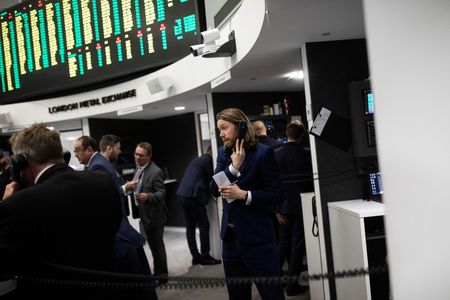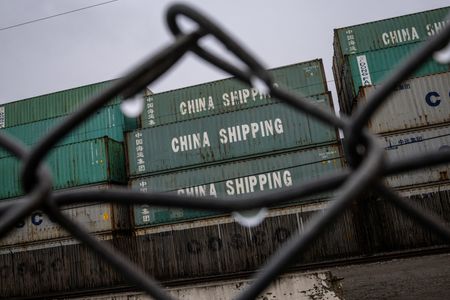By Hongmei Li, Pratima Desai, Lewis Jackson
HONG KONG/LONDON (Reuters) -Unusually large shipments of copper to the United States are unlikely to abate as long as the threat of tariffs hangs over the market and price premiums for the metal on U.S.-based COMEX make deals profitable for traders and producers, analysts said.
Since February, when U.S. President Donald Trump ordered a probe into potential new tariffs on imports of copper vital for electric vehicles, power grids and construction, prices of the metal on COMEX have soared.
COMEX copper hit a record high at $11,633 a metric ton on March 26, creating a premium of more than $1,570 a ton against the benchmark contract on the London Metal Exchange.
According to U.S. government data, copper imports in March amounted to more than 123,000 tons compared with around 58,000 tons in February and 76,000 in January.
“We expect 250,000-300,000 tons of extra copper will be shipped to the U.S. over March-May because of the spread and amid the uncertainties regarding the tariff,” said Sharon Ding, head of China basic materials at UBS Investment Research.
Ding was speaking on Tuesday at a Shanghai Metals Market event during LME Week in Hong Kong.
Some of the metal heading for the U.S. has been diverted from China, but much of it has come from LME-registered warehouses where copper stocks have dropped nearly 60% since the middle of February to 170,750 tons.
The premium for copper on COMEX has fallen to $600 a ton, a level traders say is still high enough to make a lucrative profit by sending copper to the United States.
“Anyone who could get any material into the U.S. was pretty highly incentivised to do so. I think that rolls on for a little bit longer. We’re still at super-normal (premiums),” said Marcus Garvey, head of commodities strategy at Macquarie.
UNUSUAL SHIPMENTS
Typically, traders and producers with contractual commitments transport metal using container ships as the amounts are regular and relatively small. One container can hold up to 25 tons of metal.
However, traders wanting to move quickly before tariffs are potentially imposed have been transporting metal using bulk carriers.
Container ships stop along the route to pick up cargo and can take 40 days to reach final destinations, according to a logistics source, while bulk carriers sail directly to final destinations, cutting transit time to around two weeks.
Data provider Kpler estimates 95,202 tons of copper transported on bulk carriers reached the U.S. in March and 127,539 tons in April, compared with around 44,000 tons in January and February.
In the first half of May, 71,591 tons of copper arrived in bulk carriers, according to Kpler, which highlighted larger than usual volumes from Chile, alongside unusual shipments of 10,000 tons and 4,500 tons from Germany and Spain in March and April respectively.
Germany and Spain do not typically export copper to the United States.
“It’s possible we’ll see more atypical cargos in the second half of May,” Kpler analyst Ben Ayre said. “While the COMEX price continues to run at a premium to the LME there’s a strong incentive to land refined copper in the United States.”
(Reporting by Pratima Desai in London, and Hongmei Li and Lewis Jackson in Hong Kong. Editing by Veronica Brown and Mark Potter.)











